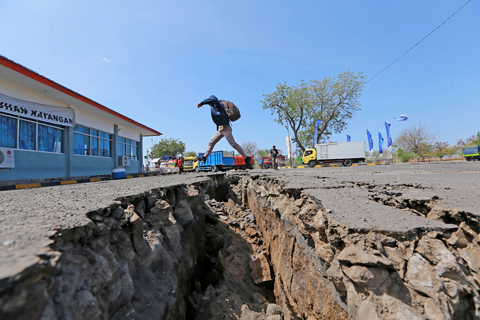Multiple quakes rock Indonesia's Lombok island, 10 dead
 MATARAM: A man jumps over a crack in the ground in Mataram on Indonesia’s Lombok island yesterday after a series of earthquakes were recorded by seismologists. — AFP
MATARAM: A man jumps over a crack in the ground in Mataram on Indonesia’s Lombok island yesterday after a series of earthquakes were recorded by seismologists. — AFPJAKARTA: The Indonesian holiday island of Lombok has been hammered by a series of powerful earthquakes in the past three weeks that have killed more than 500 people and left hundreds of thousands homeless. The archipelago nation sits on the so-called Pacific "Ring of Fire", where tectonic plates collide and many of the world's volcanic eruptions and earthquakes occur. But it is rare for one island to be hit so hard and so often. Here are some questions and answers:
What caused Lombok quakes?
The earthquakes on the island since late July are the result of a collision between the Australian and Eurasian tectonic plates just below the archipelago, geologists say. Compression of the two plates is triggering activity along a specific geological fault known as the Flores back arc thrust, which sits north of Lombok and runs roughly from the eastern end of Java island to Timor. "Clearly there are different parts of the fault that are moving at the moment, releasing those stressors," said Chris Elders, an expert in plate tectonics and structural geology at Curtin University in West Australia.
Why so many strong quakes?
Lombok was hit by two deadly quakes on July 29 and August 5. On Sunday it was rattled by a series of deadly fresh quakes and aftershocks, with the strongest measuring 6.9 magnitude. Elders said seismic activity picked up as different parts of the fault slipped and moved. However, pinpointing exactly what is causing the ruptures is more difficult - other than the fact that it shows an accumulation of stress. "The fault will move periodically when tension builds up," Danny Hilman Natawidjaja, senior geologist at the Indonesian Institute of Sciences said.
Could there be more quakes?
It is not unusual for strong earthquakes to be accompanied by scores of aftershocks, but a succession of quakes with a similar magnitude is more unusual. Adang Surahman, an earthquake engineering expert at Indonesia's Bandung Institute of Technology, described the series of tremors as "quite extraordinary"-and they may not be over. "Usually it would take a long time for another major quake to hit because the energy has been alleviated," Surahman said. "But in Lombok we had an even bigger earthquake after a major one... There may still be some imbalances and shifts."
Multiple earthquakes
At least 10 people are dead after a string of powerful quakes rocked the Indonesian holiday island of Lombok, authorities said yesterday, in a fresh blow just weeks after earlier tremors left hundreds dead and thousands more homeless. The latest quakes struck Sunday, with the first measuring 6.3 shortly before midday. It triggered landslides and sent people fleeing for cover as parts of Lombok suffered blackouts. It was followed nearly 12 hours later by a 6.9-magnitude quake and a string of powerful aftershocks.
The picturesque island next to holiday hotspot Bali was already reeling from two deadly quakes on July 29 and August 5 that killed nearly 500 people. Ten people were killed in the strong quake Sunday evening, mostly by falling debris, including six people on the neighboring island of Sumbawa, according to the national disaster agency. Some two dozen people were injured in Lombok and more than 150 homes and places of worship damaged, the agency said. Tens of thousands of homes, mosques and businesses across Lombok had already been destroyed by the quake earlier this month.
Most people caught in the latest tremor had been outside their homes or at shelters when it struck which kept casualties low, said national disaster agency spokesman Sutopo Purwo Nugroho. "The trauma because of the earlier quake on Sunday (morning) made people prefer to stay outside," he added. Aid agencies vowed to boost humanitarian assistance on the island as devastated residents struggle in makeshift displacement camps. Indonesia's disaster agency said it was accelerating efforts to rebuild destroyed homes, hospitals and schools, while Save the Children pledged to escalate its humanitarian response. "We are gravely concerned about the repeated distress caused to children by the multiple shocks," the relief agency said.- Agencies










